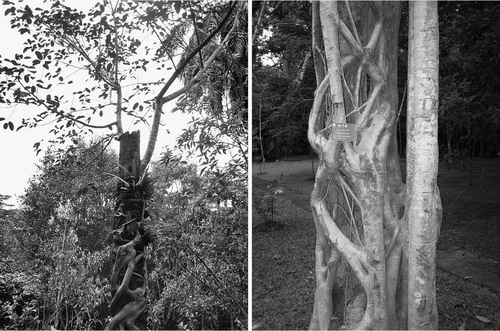Fig species are one of the most important components of tropical lowland rain forests globally with additional ecological significance due to their interactions with many plant and animal species. There are about 800 Ficus species, including shrubs, climbers, and small-to-large trees of which about 500 species have hemiepiphytic habit.
During his Ph.D studies at Xishuangbanna Tropical Botanical Garden (XTBG), Dr. Hao Guangyou and his supervisor Prof. Cao Kunfang conducted studies to compare ecophysiological traits between woody hemiepiphytic species (Hs) and non-hemiepiphytic tree species (NHs) in an evolutionary context,using common-garden plants of the genus Ficus. The aim of the study was to determine the evolutionary association of functional traits, especially hydraulic traits, with growth form divergence in hemiepiphytic (H) and non-hemiepiphytic (NH) tree species of Ficus to provide a new model for understanding the hemiepiphytic life-form.
In their study, the researchers examined the correlated evolution of 18 ecophysiological traits related to xylem water transport and leaf physiology among 14 Ficus species by applying phylogenetic independent contrast analyses with explicit phylogenetic information. They specifically tested for correlated evolution between xylem hydraulic conductivity and gas exchange and among three key functional traits that have been demonstrated crucial in plant functioning, i.e., leaf-specific hydraulic conductivity, leaf mass per area, and water use efficiency. The research was the first detailed test of hydraulic–photosynthetic coordination in a group of closely related species, and furthermore, it investigated the ecophysiological divergence between hemiepiphytic and non-hemiepiphytic tree species.
The researchers found substantial differences between hemiepiphytic and non-hemiepiphytic Ficus species grown in a common garden, in important traits relating to ecological performance, including xylem hydraulic conductivity, leaf water use, and carbon economy. The hemiepiphytic species had xylem with significantly smaller vessel lumen diameters and lower hydraulic conductivity than non-hemiepiphytic species based on both ahistoric and phylogenetic analyses, despite the relatively large variation within each growth form.
The findings support a new model for the evolution and ecology of hemiepiphytism, based on drought tolerance, at the expense of rapid hydraulic transport and gas exchange under well watered conditions as found for non-hemiepiphytic species. Ficus species of the two growth forms showed contrasting clusters of ecophysiological traits, providing an evolutionary model for the specialization.
The study entitled “Ecology of hemiepiphytism in fig species is based on evolutionary correlation of hydraulics and carbon economy” has been published in Ecology, 92:2117–2130. doi:10.1890/11-0269.1.
Abstract http://www.esajournals.org/doi/abs/10.1890/11-0269.1

(Left) Ficus curtipes of early growth stage in Xishuangbanna Tropical Botanical Garden (China), with its host tree strangled.
(Right) F. curtipes of independent growth stage following the decomposition of the strangled host tree. (Image by Hao Guangyou)

